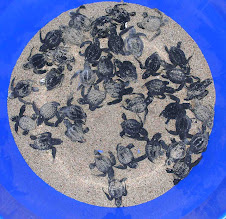¡Hola!Ya que estamos en los últimos días de la temporada 2009 de las Tortugas Golfinas me ha anotado que este blog casi no tiene información sobre los patrullajes que hacemos cada noche de la temporada para encontrar Tortugas y nidos de Tortugas. La razón por eso es que me enfoco más en el manejo de los nidos y crías ya que están bajo la protección del Grupo.
Aquí te paso unas fotos de los trabajos del grupo que pasan entre 8.30pm a las 6am.Now that we are arriving at the end of the 2009 Olive Ridley season I have noticed that this blog is lacking information on our night patrols that we make to find the turtles and nests that we protect. The reason for this is that my work focuses more on the management of nests and hatchlings once they are in the ecological groups care.
However it’s about time to include some photos of our work between 8.30pm and 6am.

Si encontramos la tortuga hembra en la playa / If we find the female turtle on the beach:
 La tortuga esta capturada para la toma de datos morfologicos, marcaje y revision para tumores, anzuelos etc./ The turtle is caught in order to take data on size, flipper tag and check for tumors, hooks etc.
La tortuga esta capturada para la toma de datos morfologicos, marcaje y revision para tumores, anzuelos etc./ The turtle is caught in order to take data on size, flipper tag and check for tumors, hooks etc.


 Tiempo para una foto!
Tiempo para una foto! /
Time for a photo! La tortuga regresa al mar
La tortuga regresa al mar /
The turtle returns to the sea. Si la tortuga no se encuentra en la playa, tenemos que encontarar el nido por medio del rastro.
Si la tortuga no se encuentra en la playa, tenemos que encontarar el nido por medio del rastro. /
If the turtle is not on the beach we have to use the track it leaves to find the nest:  Arriba puedes ver un rastro de tortuga Golfina (derecha) comparado con el rastro del Cuatrimoto (izquierda). La foto de abajo muestra la "cama" del rastro es decir la area donde la tortuga puso los huevos. Utilisamos un palo para encontrarlos.
Arriba puedes ver un rastro de tortuga Golfina (derecha) comparado con el rastro del Cuatrimoto (izquierda). La foto de abajo muestra la "cama" del rastro es decir la area donde la tortuga puso los huevos. Utilisamos un palo para encontrarlos. /
Above you can see the track left by an Olive Ridley turtle (right) compared to that of the quad bike (left). The following photo shows the tracks "bed" which is the area of the track where the turtle layed her eggs. We use a stick to find them:

Los huevos estan transportados a un vivero de proteccion. / The eggs are taken to a protected area.
Saludos
Catherine






















